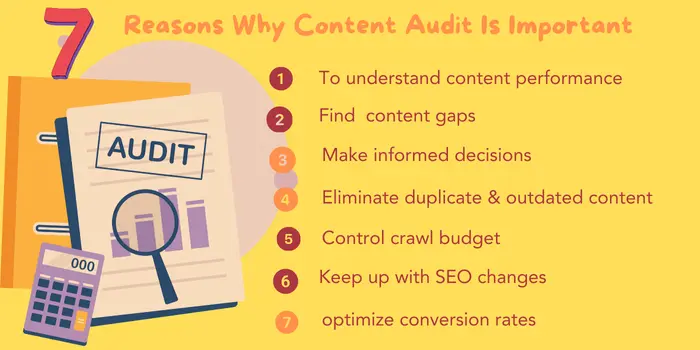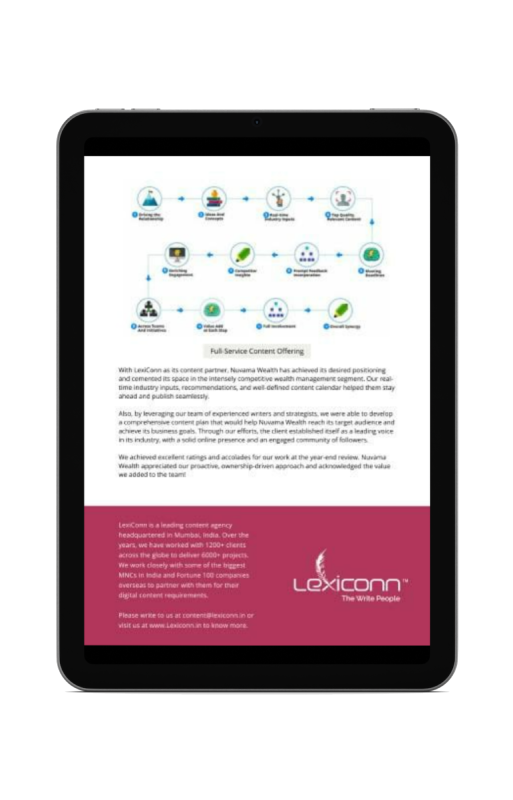
The success of content marketing in the current digital environment depends on an in-depth understanding of content performance. However, many marketers avoid the process entirely because auditing many pieces of content can appear intimidating.
But do not be alarmed. With this guide, we hope to take the ambiguity out of content auditing and give you a quick and easy way to evaluate the effectiveness of your content.
Explore the significance of content auditing, how it affects optimization, and how to quickly yet thoroughly perform a content audit. Read on to know more.
A content audit provides a thorough analysis of an organization's internet presence. It carefully assesses content performance across various KPIs, channels, and platforms, probing into every corner of a website, blog, or social media platform. It guides businesses toward engagement, expansion, and accomplishing their objectives.
The goal of a content audit is to identify the areas that require improvement and the aspects of success. Every piece of content is put through a rigorous evaluation process in which the organization's goals are used to compare the content's efficacy, relevancy, and quality.
Nothing eludes the audit's critical eye, from accuracy and relevance to alignment with brand messaging and target audience.

Content audits offer insightful information about the effectiveness of your online presence. By examining metrics like engagement, click-through rates, and conversion rates, you can better understand your content in terms of relevance and relatability.
A content audit carefully examines your content to identify any missing or inadequate elements. You can then create a more impactful content strategy that caters to your target audience's requirements and interests by recognizing these gaps.
Once you're equipped with information from content audits, you may decide how best to enhance your content and match it to your company’s objectives. Audits offer insightful information that can help direct your content strategy, whether optimizing existing material, producing new content, or reallocating resources.
Finding and eliminating outdated or duplicate content is a crucial component of content audits. You need to ensure that search engines index only meaningful and relevant material that helps your website's SEO performance and improves its overall quality.
Content audits assist in controlling the amount of time search engine bots spend efficiently crawling and indexing the pages on your website. You may maximize your crawl budget and raise your website's search engine ranking by getting rid of any irrelevant or low-quality content.
Content audits are crucial for keeping up with modifications to search engine algorithms and ranking variables, as SEO is an ever-changing field. You may maintain or increase your website's search exposure and adjust to changing SEO criteria by routinely assessing your content.
Content audits also play a critical role in optimizing conversion rates by identifying material that may be underperforming or losing its efficacy over time. You can guarantee that your content will continue efficiently promoting engagement and conversions by implementing the appropriate changes in response to audit results.
Objective 1: Boost SEO
Your content audit should concentrate on finding ways to make your website more visible in search engine results if your main objective is to boost SEO. To find opportunities for improvement, you would examine elements like keyword usage, metadata, internal linking structure, and backlink profile.
You may improve organic traffic to your website by making sure technical SEO best practices are followed and optimizing your content for relevant keywords.
Objective 2: Recognize Outdated Content
When content ages or becomes irrelevant, it can harm both SEO performance and user experience. The goal of your audit can be to find, update, or eliminate any outdated content that does not correspond with your current offers or messaging. This could contain information about past events or trends, outdated data, or discontinued goods or services.
Objective 3: Optimize for Conversions
Your audit would examine the degree to which your content encourages users to do desired activities, such as signing up, making purchases, or contacting you, if this is your main objective. To find areas for improvement, you would evaluate elements like call-to-action (CTA) placement and efficacy, content relevancy to the target audience's demands, and overall user experience.
Objective 4: Improve Click-Through Rate (CTR)
If you want to improve the CTR, increase page views, and campaign effectiveness by streamlining content and improving user interaction components.
Objective 5: Reduce Bounce Rate
If your objective is to reduce the bounce rate, find and fix problems with SEO and content that detract from the user experience. You can offer ways to lower bounce rates and increase website user engagement.
Objective 6: Maximize Conversion Rates
If you want to attract and convert qualified audiences, invest in site setup and content modifications to maximize conversion rates. Businesses may boost marketing and sales conversions by optimizing their marketing strategy.
SEO Metrics
These include search results' click-through rates (CTR), keyword ranks, organic traffic, backlinks, and more. Keeping an eye on these metrics enables you to evaluate how well your content promotes your website organically and increases search engine exposure.
User Behavior Metrics
You can learn much about how visitors engage with your content by looking at metrics like pageviews, engagement rate, bounce rate, and others. To improve the user experience generally, it is helpful to understand user behavior to identify areas that need optimization and development.
Metrics of Engagement
Likes, shares, comments, and mentions are engagement metrics. These show how involved and interested your audience is in your work. Measuring the resonance and efficacy of content in drawing in viewers and encouraging community involvement is easier by analyzing engagement indicators.
Sales Analytics
The emphasis of these analytics is on how content marketing affects revenue and sales. These consist of sales measures, such as ROI, conversion rates, and lead generation volume. Monitoring sales analytics makes it easier to assess how well content marketing campaigns generate revenue and conversions.
Gathering all of the content for your website into a format that is easily accessible and editable—like a spreadsheet or specialized tool—is essential before you begin data analysis.
This first step is crucial because it sets the stage for an extensive website audit. Using a sitemap is the most straightforward method of collecting inventory data. If you don't already have one, you should immediately make one for your website.
Pay attention to fixed pages such as "About Us," "Contact," and "Privacy Policy," as well as posts that contain important keywords related to your company.
URL: The content page's web address.
Page Title: The content page's title.
Page Purpose: A succinct explanation of the content's objective, such as a how-to manual for conducting a content audit.
Focus Keywords: Those that are used to make material more search engine friendly.
Average Ranking Rank: The average rank of the main target keyword in search engine results.
Backlinks: The quantity of outside connections that lead to the content page.
Content Type: The kind of material, such as news articles or blog posts.
Content Format: The way the content is presented, whether it's text-only, image-only, or video-inclusive.
Date of Publication or Last Modification: The date on which the information was most recently updated or released for publication.
Content Hub: The theme grouping or content cluster that the material is a part of is called the content hub (cluster).
Author: The person or organization in charge of writing the material.
Google Analytics
This robust online analytics tool offers insightful data on user behavior, website traffic, and conversions. Metrics like page views, bounce rates, session lengths, and traffic sources may all be monitored using it. You can use Google Analytics to examine user demographics, behavior patterns, and the effectiveness of certain pages or content categories.
This data presents opportunities for optimization and aids in your understanding of the material that connects with your audience the most.
Google Search Console
Previously called Google Webmaster Tools, Google Search Console is a free tool that assists you in keeping an eye on and maintaining your website's visibility in Google Search results.
It offers information on the keywords people use to locate your website, how your website shows up in search results, and any indexing problems or mistakes that might be lowering your website's visibility. Insights on search queries, click-through rates, and impressions are also provided by Google Search Console, which helps you spot areas where search engine optimization (SEO) can be strengthened.
Content Auditing Software
Several content auditing solutions are available to make the process of cataloging, evaluating, and refining website content easier. Features like keyword tracking, content scoring, metadata analysis, automated content crawling, and performance reporting are often included in these solutions.
Software for content audits can assist you in finding out-of-date or underperforming content, finding areas for development, and monitoring your progress over time. Tools for well-liked content auditing include Ahrefs, SEMrush, and Screaming Frog.
Use Content Audit Services
Content Audit Services comprehensively analyze and review every piece of content on your website, blog, or digital platform. These services usually evaluate your content's effectiveness, relevancy, and quality using sophisticated tools and techniques. They suggest improving your content strategy and assist in identifying areas that need work, such as out-of-date or underperforming material.
They offer insight into SEO optimization, user experience improvements, and content marketing techniques. With LexiConn, you can get fast and effective content audit results.
It's now time to evaluate each piece of content in light of your goals and designate the necessary actions using the data gathered and metrics established:
Hold
Well-performing and still-relevant content might need to be updated immediately later. Some examples are evergreen content, success stories, FAQs, and basic business information.
Repurpose
Pages that perform particularly well can be put to new uses to capitalize on their performance. For example, a blog or article with excellent performance can be converted into a lead-generating tool, such as a downloadable template, to generate more leads through paid channels.
Update
Point out websites that require updating or that include outdated information. Review and improve these pages to increase their efficacy. This could entail updating blog entries with dated data, editing articles containing outdated material, or optimizing content for low traffic or conversion rates.
Delete
Anything beyond repair or outlived its usefulness ought to be taken down. Eliminating unnecessary or duplicate material is crucial since it can harm organic performance if low-quality content is kept around. Examples include information regarding out-of-stock products, outdated advertising materials, and content tied to previous events or activities.
Content audit calls for coordinating your efforts with your long-term content strategy too. You may modify your approach to connect with your target audience more effectively and produce greater results by remembering your triumphs and failures.
The following practical advice will help you fine-tune your approach:
Utilize Effective Content
Pay attention to your best-performing material and consider how you may build on its achievements. Determine recurring themes or components your audience finds engaging and apply them to the next content projects.
Learn from Mistakes
Examine your least effective material to extract knowledge and strategies from poorly performing sections. Recognize the reasons behind the failure of some material to connect with your audience and use these insights to steer clear of the same mistakes in the future.
Analyze the Competition's Content
tactics to find opportunities for creativity and advancement. To improve your strategy and maintain your position as a leader in your field, take note of their accomplishments and failures.
Plan Frequent Strategy Reviews
and content audits, preferably once a year at the very least, to ensure they align with business goals and market developments. To keep your plan relevant and effective, make necessary adjustments.
Remain Dynamic and Flexible
Setting up more regular review periods is crucial for keeping up with trends and difficulties in fields like cybersecurity that see frequent change. Keep an eye out for changes in the industry and adjust your content strategy as necessary. Flexibility guarantees that your content is updated and relevant, whether updating marketing materials or providing real-time warnings.
With this guide, you can perform content audits and boost your business success online. Visit www.lexiconn.in or drop us a line at [email protected] to get personalized expert services and conduct your business' content audit in 15 minutes!
If you require content consultation, you can book a free thirty-minute session with us. Book your meeting today.


I have read and accept the Privacy Policy
Read More